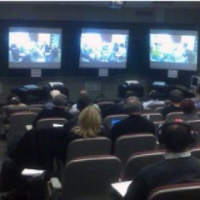Trial Presentation High-Quality Solutions for Courtroom Presentations
Trial Presentation High-Quality Solutions for Courtroom Presentations
Blog Article
Astound the Jury: Essential Components of a Powerful Test Presentation
Crucial elements such as comprehending the target market, crafting a compelling narrative, and understanding verbal and non-verbal interaction are vital elements of a reliable presentation. As these elements link, they form a natural technique that not only notifies yet additionally involves jurors on numerous levels.

Comprehending Your Target Market
Understanding your target market is a crucial aspect of efficient trial discussion. A successful presentation rests on the ability to realize the demographics, values, and predispositions of jurors. This comprehension educates exactly how disagreements are mounted, evidence exists, and emotional appeals are crafted, guaranteeing that the message resonates with the jurors on an individual degree.
Research study indicates that jurors come from diverse backgrounds and may have differing degrees of comprehending concerning legal proceedings. In addition, recognizing the jurors' prospective biases and life experiences allows the test presenter to anticipate arguments and address worries proactively.
Efficient test presentation additionally involves observing jurors' responses throughout the procedures. Involving with jurors as individuals instead than a cumulative device is necessary in fostering a strong connection in the court.

Crafting an Engaging Narrative
Crafting a compelling story is vital in guiding jurors via the intricacies of an instance. A well-structured narrative not just simplifies complex legal concepts yet additionally involves jurors on an emotional level, making the info extra relatable and unforgettable.
This message needs to reverberate with the jurors' values and experiences, promoting a link that goes beyond mere truths. This sequential approach can aid jurors follow the progression of occasions, emphasizing cause and result.
Including human components-- such as personal stories or narratives-- can additionally improve the story's influence. These components stimulate compassion, allowing jurors to picture the repercussions of the situation on the real worlds. Additionally, using a constant motif throughout the discussion enhances the primary debate, making it simpler for jurors to keep crucial points.
Ultimately, a compelling story transforms a trial presentation from a simple address of realities right into a convincing story that captivates the jury, encouraging them to mull over with both reason and emotion.
Utilizing Aesthetic Help
Incorporating aesthetic help into a test discussion can substantially enhance jurors' understanding and retention of information. Visual products such as graphes, representations, photos, and videos can change complex lawful ideas and evidence into easily absorbable styles. By involving multiple detects, these aids permit jurors to envision the case's vital aspects, making it much easier for them to adhere to along and understand intricate information.
Additionally, properly designed visual help can emphasize crucial points and highlight relationships in between various pieces of proof. As an example, timelines can effectively illustrate the series of events, while annotated photos can clear up certain details pertinent to the case. This not just help in understanding however also reinforces the advice story offered by the lawyer.
Overly complex or chaotic visuals may overwhelm jurors and detract from the message. Inevitably, efficient aesthetic interaction can be an effective tool in convincing jurors and aiding them get to educated conclusions.
Mastering Verbal Communication
Efficient why not try here verbal communication is crucial in a trial presentation, as it serves as the primary means whereby attorneys convey their arguments and connect with jurors. Grasping this skill involves clarity, persuasion, and interaction. Attorneys should verbalize their factors plainly and concisely, preventing lawful lingo that might puzzle jurors. Simpleness in language promotes understanding and assists jurors comprehend intricate concerns presented during the trial.
Furthermore, tone and pacing significantly impact exactly how messages are received. A confident tone shares authority, while suitable pacing allows jurors to soak up info without really feeling overwhelmed. Lawyers must also vary their vocal inflections to emphasize bottom lines and maintain jurors' passion throughout the presentation.
Additionally, the company of spoken arguments is important. Structuring the narrative realistically and coherently helps jurors comply with the attorney's logic, making it easier for them to keep crucial details. Using influential strategies, such as storytelling, can additionally improve the psychological vibration of the arguments provided, consequently developing a more extensive connection with jurors.
Inevitably, understanding verbal interaction not only reinforces an attorney's instance however additionally promotes count on and connection with the court, substantially boosting the opportunities of a beneficial judgment.

Engaging With Body Language
Nonverbal interaction plays an essential function in test presentations, commonly communicating messages that words alone can not express. Body movement, encompassing motions, pose, facial expressions, and eye call, considerably influences how jurors view the other integrity and sincerity of the presenter. A certain position, with shoulders back and an open posture, can infuse trust, while closed-off body language might suggest defensiveness or uncertainty.

Facial expressions need to show the feelings connected with the situation, strengthening the narrative being offered. As an example, an honest expression during an emotional moment can elicit compassion and reinforce the sob story. Ultimately, mastering body movement is important for efficient test discussions, as it boosts verbal interaction and establishes a compelling existence that resonates with the jury.
Verdict
Finally, astounding the court necessitates a calculated strategy that includes comprehending the target market, crafting an engaging story, using visual aids, mastering verbal interaction, and involving via body movement. Each element plays a crucial role in developing an effective test presentation that resonates with jurors on both psychological and intellectual levels (trial presentation). By integrating these components successfully, lawyers can considerably improve their capability to convince and affect court decision-making
Report this page